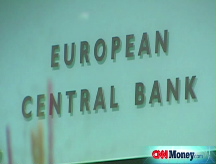Cost of borrowing falls further
Interbank lending rates fall overnight. Treasury prices are mixed, with the 30-year bond declining on renewed confidence about the future.
| ||
 |
NEW YORK (CNNMoney.com) -- Lending rates remained near historically low levels Wednesday as banks struggled to put the credit crisis behind them.
Prices for ultra-safe U.S. Treasury bills were mixed as stocks fell and investors geared up for several debt auctions scheduled for next week.
The 3-month Libor rate dropped to 2.39% from 2.51% on Wednesday, according to Bloomberg.com. Thursday's rate is the lowest since Nov. 25, 2004, when it was also 2.39%.
The overnight Libor rate rose slightly, bouncing off an all-time low, to 0.33% from 0.32%. The rate had been falling for 7 days in a row.
Libor, the London Interbank Offered Rate, is a daily average of what 16 different banks charge other banks to lend dollars in the U.K. and is a key barometer of liquidity in the credit market.
Libor rates have been retreating since mid-October, when the Federal Reserve flooded 13 central banks around the globe with unlimited amounts of dollars.
Less than a month ago, 3-month Libor was at 4.82%, and the overnight rate was at an all-time high of 6.88%. Lower rates are a major boon for the troubled credit markets because more than $350 trillion in assets are tied to Libor.
"Banks are beginning to come into line," said Bob Brusca, economist at Fact and Opinion Economics in New York. "But the real question is the economy."
While banks are becoming more willing to lend to each other, they remain reluctant to lend to customers, which hampers economic activity, Brusca said.
"When economic conditions get bad, banks pull back. That makes economic conditions even worse, and banks pull back more. It's a vicious circle," he said.
Central banks world wide have taken unprecedented steps to shore up the economy amid growing sings of a global recession.
In a widely expected move, the European Central Bank cut its benchmark interest rate on the main refinancing operations of the Eurosystem by one half percentage point, to 3.25%.
Meanwhile, the Bank of England slashed its key lending rate by a bigger than expected 1.5 percentage points to 3%, citing worsening economic conditions in the U.K. and around the world.
Playing it safe: U.S. Treasury prices were mixed Thursday as stock prices fell sharply and the market prepared for next week's auctions.
"We had a good rally in Treasurys," said Steve Van Order, chief fixed income strategist at Calvert Funds. But he added that the market is now "pulling back" ahead of a big influx of supply.
The benchmark 10-year note rose 3/32 to 102-16/32 with a yield dipping to 3.70%. Bond prices and yields move in opposite directions.
The 2-year note rose 4/32 to 100-13/32 with a yield of 1.3%.
The spread between the 2-year and the 10-year yield, a key measure of market sentiment, widened slightly to 2.40 percentage points from 2.32 percentage points Wednesday. A wider spread, or a higher yield curve, indicates a weaker economic environment. The yield curve reached a near 5-year high Tuesday.
The 30-year long bond fell 13/32 to 105-3/32 and its yield rose to 4.2% from 4.13%.
The yield on the 3-month bill fell to 0.3% from 0.4%. This yield is closely watched as an immediate reading on investor confidence. Investors and money-market funds shuffle money into and out of the 3-month bill frequently, as they assess risk in the rest of the marketplace. A lower yield suggests less optimism.
Market confidence: Key indicators of market confidence continued to show signs of improvement Thursday.
The Libor-OIS spread fell to 1.83 percentage points from 1.93 points on Wednesday. The spread measures the difference between actual borrowing costs and the expected official borrowing rate from the Fed. It is used as a gauge to determine how much cash is available for lending between banks. The bigger the spread, the less cash is available for lending.
While the indicator has fallen from a high of 3.66 points set last month, it is still far above the 0.11 percentage point seen prior to Sept. 15 when Lehman Brothers' bankruptcy filing sparked intense concern about the U.S. and global economies.
Another indicator, the "TED spread," fell to 2.09 percentage points from 2.12 points on Wednesday.
The TED spread measures the difference between the 3-month Libor and the 3-month Treasury bill, and is a key indicator of risk. The higher the spread, the less willing investors are to take risks.
The TED spread has fallen from an all-time high of 4.63 points set in mid-October. It was at 1.04 percentage points just days before Wall Street's crisis.
Did you vote for Obama? How do you think the new president will affect your wallet? What do you think Obama needs to do to fix the economy - both in the short run and the long term? What should be first on the new Congress's agenda? E-mail us your thoughts, including your name, photo and contact info; the best answers will be featured in an upcoming CNNMoney.com article. ![]()




